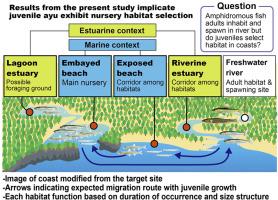Estuarine, Coastal and Shelf Science ( IF 2.8 ) Pub Date : 2020-05-13 , DOI: 10.1016/j.ecss.2020.106831 Atsunobu Murase , Tetsuya Ishimaru , Yukiya Ogata , Yuta Yamasaki , Hidenobu Kawano , Kenji Nakanishi , Kaito Inoue

|
The use of estuarine and marine ecosystems by amphidromous fishes has not been thoroughly studied, especially with respect to habitat types. Here, abundance and size comparisons of juveniles of an amphidromous fish, ayu (Plecoglossus altivelis altivelis), were performed among four types of topographically distinct shallow, soft-bottom habitats across two different environmental contexts (marine and estuarine) through monthly seining along an estuary–ocean ecotone in southern Japan. Topography (open/enclosed and presence/absence of surf zone) and environmental parameters (water temperature and salinity) differed among the four habitats, i.e., riverine estuary, exposed beach, embayed beach, and lagoon estuary. The peak month of juvenile abundance also differed among habitats (riverine estuary in December, exposed beach in January, embayed beach and lagoon estuary in March), as did the mean standard length (riverine estuary < exposed beach < embayed beach < lagoon estuary), although the abundance at embayed beach was significantly greater than in the two estuaries, and almost all size classes of juveniles occurred at embayed beach. A likely explanation for these patterns is that juvenile ayu select coastal habitats as they develop swimming ability and that riverine estuary/exposed beach, embayed beach, and lagoon estuary function as a corridor, primary nursery, and possible foraging ground, respectively. These findings, coupled with implications from previous studies of habitat selection in coasts by anadromous fishes, highlight the importance of seascape-level analysis for elucidating the nursery functions of coastal habitats, even for diadromous nekton.
Regional terms
North-western Pacific, East Asia, Japan, Kyushu, Miyazaki Prefecture.
中文翻译:

两栖性神经元的托儿所在哪里?不同栖息地和环境中幼鱼的丰度和大小比较
两栖鱼类对河口和海洋生态系统的利用尚未得到彻底研究,尤其是在生境类型方面。在此,对两栖鱼类(Ayu)(Plecoglossus altivelis altivelis)的幼体的丰度和大小进行比较)是通过在日本南部的河口-海洋过渡带每月围网,在两种不同环境背景下(海洋和河口)对四种类型的地形明显的浅层软底生境进行的。四个生境,即河口,裸露的海滩,隐蔽的海滩和泻湖河口的四个生境之间的地形(开放/封闭和有无冲浪区)和环境参数(水温和盐度)不同。不同生境之间的少年丰年高峰也有所不同(12月河口,1月裸露的海滩,3月内陷海滩和泻湖河口),以及平均标准长度(里维埃河口<裸露海滩<内陷海滩<泻湖河口),尽管掩埋海滩的丰度明显高于两个河口,几乎所有大小的少年都发生在隐蔽的海滩上。对这些模式的一种可能解释是,幼鱼在发展游泳能力时会选择沿海栖息地,而河口/裸露的海滩,隐蔽的海滩和泻湖河口分别充当走廊,主要苗圃和可能的觅食场。这些发现,再加上先前对无性鱼类在沿海地区进行生境选择的研究的启示,凸显了海景水平分析对于阐明沿海生境的育苗功能,甚至对于介导的线虫的重要性。泻湖河口和泻湖河口分别用作走廊,主要苗圃和可能的觅食场。这些发现,再加上先前对无性鱼类在沿海地区进行生境选择的研究的启示,凸显了海景水平分析对于阐明沿海生境的育苗功能,甚至对于介导的线虫的重要性。泻湖河口和泻湖河口分别用作走廊,主要苗圃和可能的觅食场。这些发现,再加上先前对无性鱼类在沿海地区进行生境选择的研究的启示,凸显了海景水平分析对于阐明沿海生境的育苗功能,甚至对于介导的线虫的重要性。
地区条款
西北太平洋,东亚,日本,宫崎县九州。



























 京公网安备 11010802027423号
京公网安备 11010802027423号